Page 35 of 354
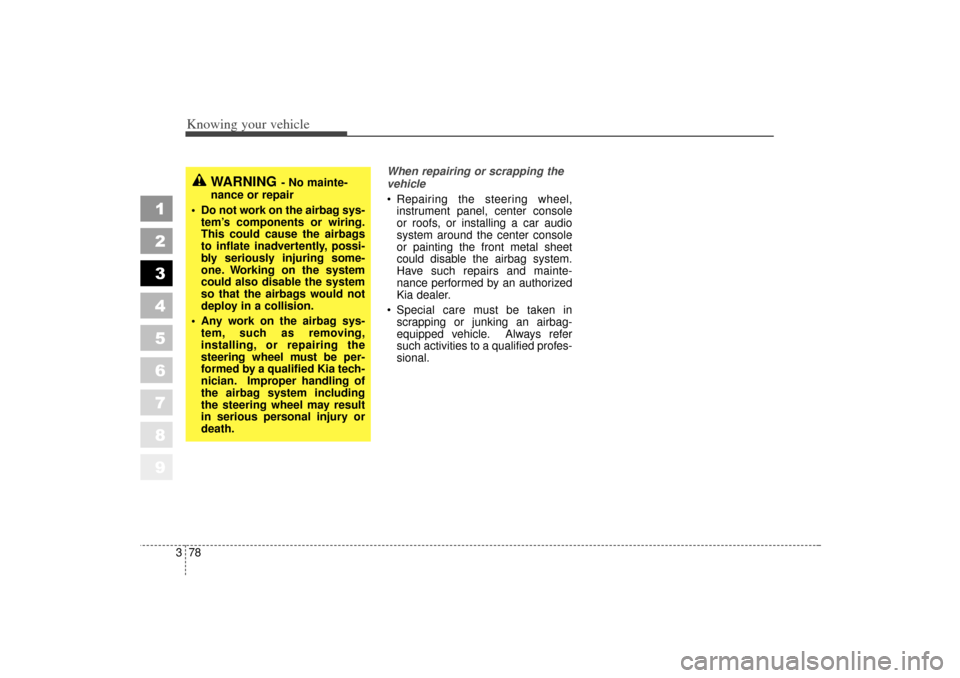
Knowing your vehicle78
3
1
2
3
4
5
6
7
8
9
When repairing or scrapping the
vehicle
Repairing the steering wheel,
instrument panel, center console
or roofs, or installing a car audio
system around the center console
or painting the front metal sheet
could disable the airbag system.
Have such repairs and mainte-
nance performed by an authorized
Kia dealer.
Special care must be taken in scrapping or junking an airbag-
equipped vehicle. Always refer
such activities to a qualified profes-
sional.
WARNING
- No mainte-
nance or repair
Do not work on the airbag sys- tem’s components or wiring.
This could cause the airbags
to inflate inadvertently, possi-
bly seriously injuring some-
one. Working on the system
could also disable the system
so that the airbags would not
deploy in a collision.
Any work on the airbag sys- tem, such as removing,
installing, or repairing the
steering wheel must be per-
formed by a qualified Kia tech-
nician. Improper handling of
the airbag system including
the steering wheel may result
in serious personal injury or
death.
KM CAN (ENG) 3 (55~)new.qxd 7/29/05 9:37 AM Page 78
Page 36 of 354
379
1
2
3
4
5
6
7
8
9
Knowing your vehicle
Airbag warning labelAirbag warning labels which are now required by the Canadian Motor Vehicle Safety Standard (CMVSS) are attached
to alert driver and passengers of potential risk of airbag system.
Note that these government warnings focus on the risk to children, Kia also wants you to be aware of the risks which
adults are exposed to. Those have been described in previous pages.
1KMA2085/6KMC3001/1KMB1039/1KMB1035
➀
➂
(if equipped)
➁
(if equipped)
KM CAN (ENG) 3 (55~)new.qxd 7/29/05 9:37 AM Page 79
Page 67 of 354
101
2
3
4
5
6
7
8
9
Keys / 3-2
Remote keyless entry / 3-3
Theft-alarm system / 3-5
Immobilizer system / 3-7
Door locks / 3-9
Window / 3-16
Seat / 3-19
Safety belts / 3-30
Airbags-supplemental restraint system / 3-54
Hood / 3-80
Fuel filler lid / 3-82
Mirrors / 3-85
Interior lights / 3-89
Storage compartment / 3-91
Interior features / 3-94
Sunroof / 3-100
Luggage net / 3-104
Tonneau cover / 3-105
Luggage center box / 3-107
Roof rack / 3-108
Antenna / 3-109
Knowing your vehicle
10
KM CAN (ENG) 3 (~54)new.qxd 7/29/05 9:33 AM Page 1
Page 86 of 354
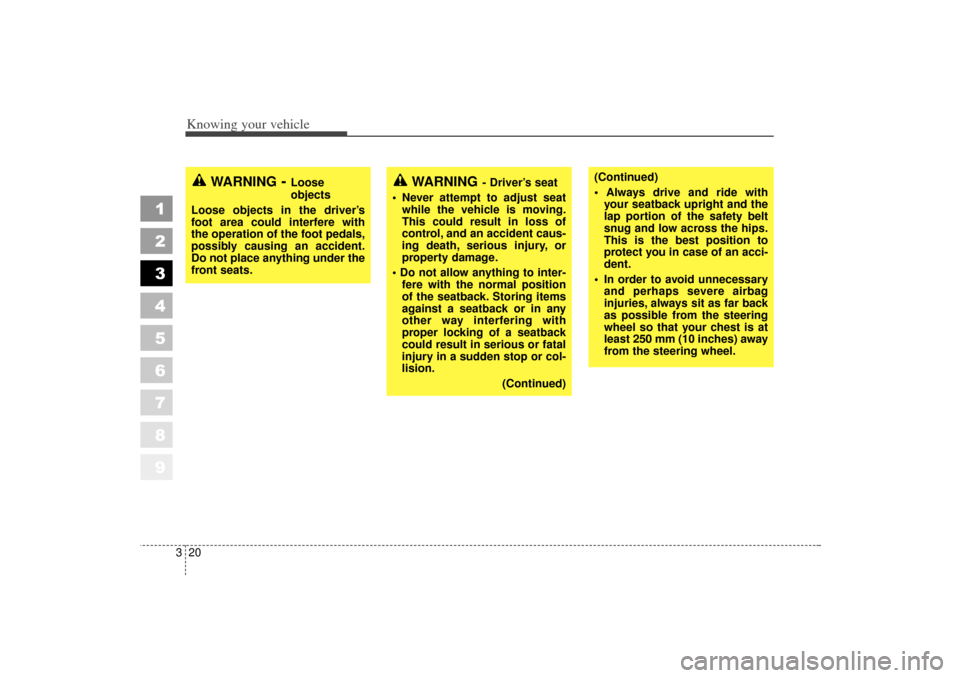
Knowing your vehicle20
3
1
2
3
4
5
6
7
8
9
(Continued)
Always drive and ride with
your seatback upright and the
lap portion of the safety belt
snug and low across the hips.
This is the best position to
protect you in case of an acci-
dent.
In order to avoid unnecessary and perhaps severe airbag
injuries, always sit as far back
as possible from the steering
wheel so that your chest is at
least 250 mm (10 inches) away
from the steering wheel.
WARNING
- Loose
objects
Loose objects in the driver’s
foot area could interfere with
the operation of the foot pedals,
possibly causing an accident.
Do not place anything under the
front seats.
WARNING
- Driver’s seat
Never attempt to adjust seat while the vehicle is moving.
This could result in loss of
control, and an accident caus-
ing death, serious injury, or
property damage.
Do not allow anything to inter- fere with the normal position
of the seatback. Storing items
against a seatback or in any
other way interfering with
proper locking of a seatback
could result in serious or fatal
injury in a sudden stop or col-
lision.
(Continued)
KM CAN (ENG) 3 (~54)new.qxd 7/29/05 9:33 AM Page 20
Page 96 of 354
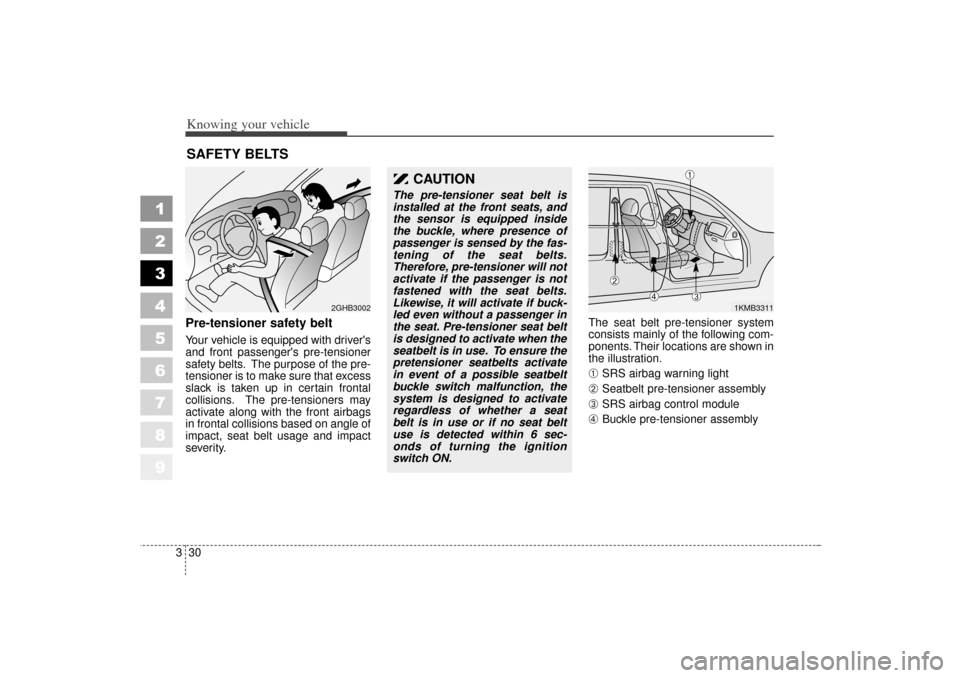
Knowing your vehicle30
3
1
2
3
4
5
6
7
8
9
Pre-tensioner safety belt Your vehicle is equipped with driver's
and front passenger's pre-tensioner
safety belts. The purpose of the pre-
tensioner is to make sure that excess
slack is taken up in certain frontal
collisions. The pre-tensioners may
activate along with the front airbags
in frontal collisions based on angle of
impact, seat belt usage and impact
severity. The seat belt pre-tensioner system
consists mainly of the following com-
ponents. Their locations are shown in
the illustration.
➀
SRS airbag warning light
➁
Seatbelt pre-tensioner assembly
➂
SRS airbag control module
➃
Buckle pre-tensioner assembly
SAFETY BELTS
2GHB3002
1KMB3311
➀
➁
➂
➃
CAUTION
The pre-tensioner seat belt is
installed at the front seats, and
the sensor is equipped inside
the buckle, where presence of
passenger is sensed by the fas-
tening of the seat belts.
Therefore, pre-tensioner will not
activate if the passenger is not
fastened with the seat belts.
Likewise, it will activate if buck-
led even without a passenger in
the seat. Pre-tensioner seat belt
is designed to activate when the
seatbelt is in use. To ensure the
pretensioner seatbelts activate
in event of a possible seatbelt
buckle switch malfunction, the
system is designed to activate
regardless of whether a seat
belt is in use or if no seat belt
use is detected within 6 sec-
onds of turning the ignition
switch ON.
KM CAN (ENG) 3 (~54)new.qxd 7/29/05 9:33 AM Page 30
Page 97 of 354
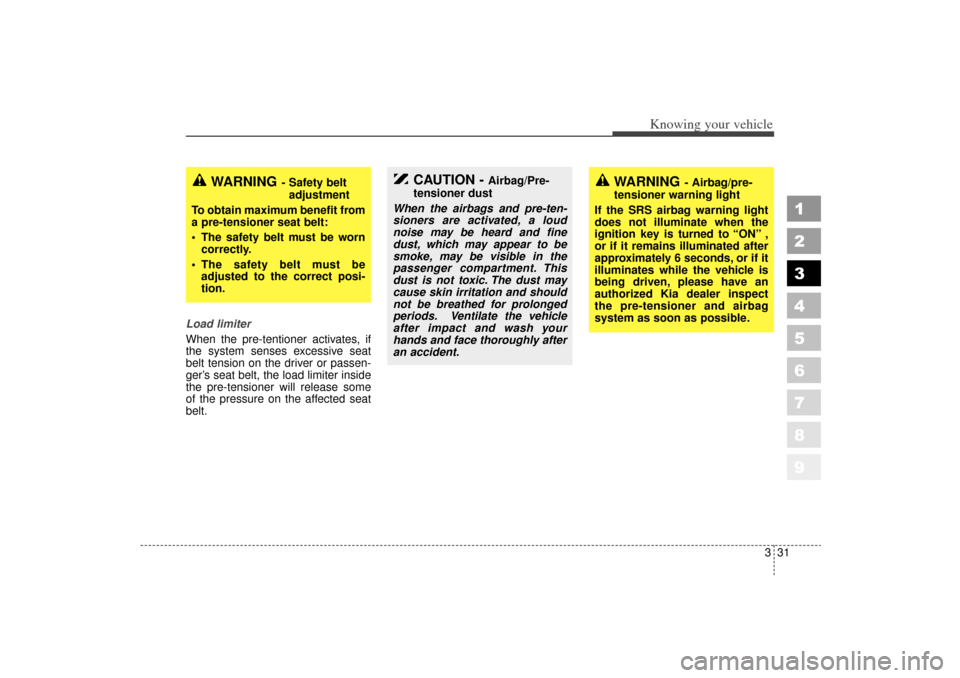
331
Knowing your vehicle
1
2
3
4
5
6
7
8
9
Load limiter
When the pre-tentioner activates, if
the system senses excessive seat
belt tension on the driver or passen-
ger’s seat belt, the load limiter inside
the pre-tensioner will release some
of the pressure on the affected seat
belt.
CAUTION -
Airbag/Pre-
tensioner dust
When the airbags and pre-ten-
sioners are activated, a loud
noise may be heard and fine
dust, which may appear to be
smoke, may be visible in the
passenger compartment. This
dust is not toxic. The dust may
cause skin irritation and should
not be breathed for prolonged
periods. Ventilate the vehicle
after impact and wash your
hands and face thoroughly after
an accident.
WARNING
- Airbag/pre-
tensioner warning light
If the SRS airbag warning light
does not illuminate when the
ignition key is turned to “ON” ,
or if it remains illuminated after
approximately 6 seconds, or if it
illuminates while the vehicle is
being driven, please have an
authorized Kia dealer inspect
the pre-tensioner and airbag
system as soon as possible.
WARNING
- Safety belt adjustment
To obtain maximum benefit from
a pre-tensioner seat belt:
The safety belt must be worn correctly.
The safety belt must be adjusted to the correct posi-
tion.
KM CAN (ENG) 3 (~54)new.qxd 7/29/05 9:33 AM Page 31
Page 99 of 354
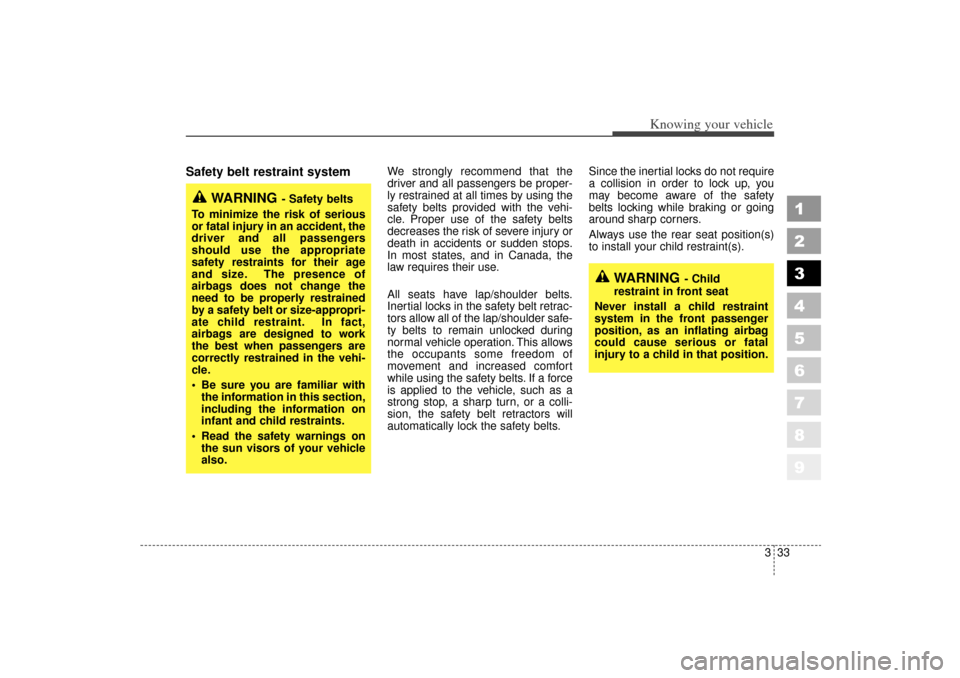
333
Knowing your vehicle
1
2
3
4
5
6
7
8
9
Safety belt restraint system
We strongly recommend that the
driver and all passengers be proper-
ly restrained at all times by using the
safety belts provided with the vehi-
cle. Proper use of the safety belts
decreases the risk of severe injury or
death in accidents or sudden stops.
In most states, and in Canada, the
law requires their use.
All seats have lap/shoulder belts.
Inertial locks in the safety belt retrac-
tors allow all of the lap/shoulder safe-
ty belts to remain unlocked during
normal vehicle operation. This allows
the occupants some freedom of
movement and increased comfort
while using the safety belts. If a force
is applied to the vehicle, such as a
strong stop, a sharp turn, or a colli-
sion, the safety belt retractors will
automatically lock the safety belts.Since the inertial locks do not require
a collision in order to lock up, you
may become aware of the safety
belts locking while braking or going
around sharp corners.
Always use the rear seat position(s)
to install your child restraint(s).
WARNING
- Safety belts
To minimize the risk of serious
or fatal injury in an accident, the
driver and all passengers
should use the appropriate
safety restraints for their age
and size. The presence of
airbags does not change the
need to be properly restrained
by a safety belt or size-appropri-
ate child restraint. In fact,
airbags are designed to work
the best when passengers are
correctly restrained in the vehi-
cle.
Be sure you are familiar with the information in this section,
including the information on
infant and child restraints.
Read the safety warnings on the sun visors of your vehicle
also.
WARNING
- Child
restraint in front seat
Never install a child restraint
system in the front passenger
position, as an inflating airbag
could cause serious or fatal
injury to a child in that position.
KM CAN (ENG) 3 (~54)new.qxd 7/29/05 9:33 AM Page 33
Page 110 of 354
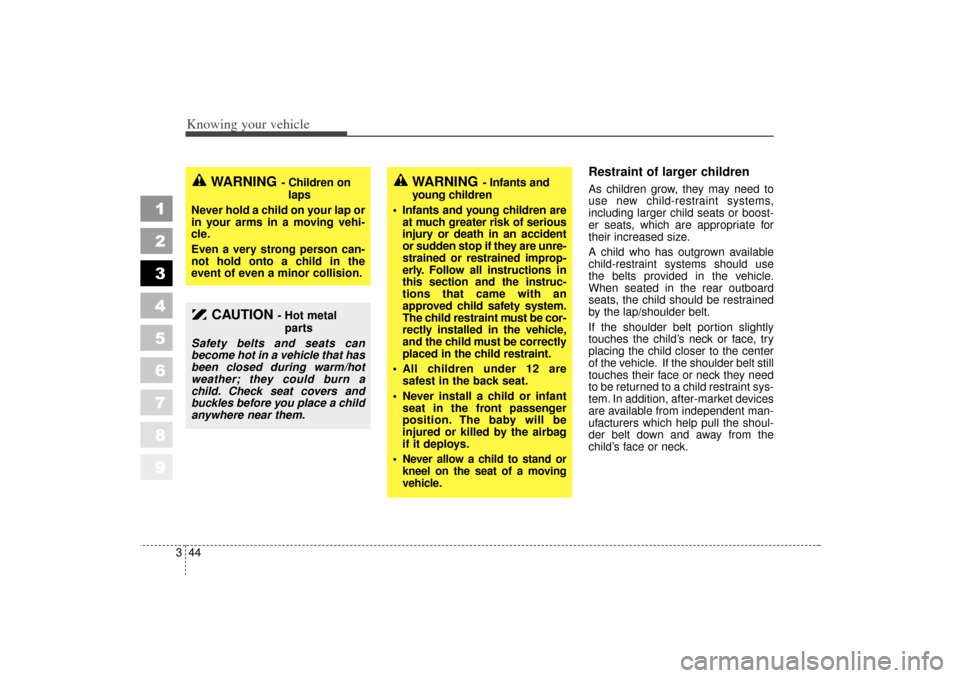
Knowing your vehicle44
3
1
2
3
4
5
6
7
8
9
Restraint of larger children As children grow, they may need to
use new child-restraint systems,
including larger child seats or boost-
er seats, which are appropriate for
their increased size.
A child who has outgrown available
child-restraint systems should use
the belts provided in the vehicle.
When seated in the rear outboard
seats, the child should be restrained
by the lap/shoulder belt.
If the shoulder belt portion slightly
touches the child’s neck or face, try
placing the child closer to the center
of the vehicle. If the shoulder belt still
touches their face or neck they need
to be returned to a child restraint sys-
tem. In addition, after-market devices
are available from independent man-
ufacturers which help pull the shoul-
der belt down and away from the
child’s face or neck.
WARNING
- Infants and
young children
Infants and young children are at much greater risk of serious
injury or death in an accident
or sudden stop if they are unre-
strained or restrained improp-
erly. Follow all instructions in
this section and the instruc-
tions that came with an
approved child safety system.
The child restraint must be cor-
rectly installed in the vehicle,
and the child must be correctly
placed in the child restraint.
All children under 12 are safest in the back seat.
Never install a child or infant seat in the front passenger
position. The baby will be
injured or killed by the airbag
if it deploys.
Never allow a child to stand or
kneel on the seat of a moving
vehicle.
WARNING
- Children on laps
Never hold a child on your lap or
in your arms in a moving vehi-
cle.
Even a very strong person can-
not hold onto a child in the
event of even a minor collision.
CAUTION
- Hot metal parts
Safety belts and seats can
become hot in a vehicle that has
been closed during warm/hot
weather; they could burn a
child. Check seat covers and
buckles before you place a child
anywhere near them.
KM CAN (ENG) 3 (~54)new.qxd 7/29/05 9:33 AM Page 44